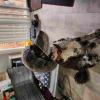Hello Everyone,
Can anyone, please, tell me if I should be including testing for Dithiocarbamates in my MRL testing of Australian grown fresh stone fruit for Australia and UK markets?
Thanks,
Raechel.

Posted 18 January 2016 - 11:27 PM
Hello Everyone,
Can anyone, please, tell me if I should be including testing for Dithiocarbamates in my MRL testing of Australian grown fresh stone fruit for Australia and UK markets?
Thanks,
Raechel.
Posted 19 January 2016 - 01:23 AM
Hi Raechel
Yes think you should include that in you testing program.
I refer you to Chemical Industry News Issue : 782015. Following is the summary from the above reference
Dithiocarbamates and stone fruit
Maresa Heath, Project Officer, Plant Residues
A national produce monitoring program conducted in 2013/14 identified unacceptable residues of dithiocarbamates in Victorian grown apricots. Dithiocarbamates are a group of fungicides commonly used in the horticulture industry to control various fungal diseases. In the stone fruit industry, this group of fungicides is mostly used to control brown rot and freckle.
A total of 238 Victorian grown apricots were sampled and analysed in this financial year. Of these, 36 were found to have dithiocarbamate residues exceeding the Australian Pesticide and Veterinary Medicines (APVMA) maximum residue limit (MRL) of 3 mg/kg for stone fruit, indicating the possible misuse of a dithiocarbamate product. As a result, traceback investigations were conducted to identify the growers of the produce.
With the exception of one, all of these produce samples originated from the Goulburn Valley (GV) region. The 36 samples with unacceptable residues were taken from 24 growers in the GV. The concentration of the unacceptable residues ranged from 3.2 mg/kg to 10 mg/kg. The residues were detected in various apricot varieties. It is important to note that the safety margin used when establishing an MRL means that none of the residues posed any concern to human health.
The tracebacks revealed:
· All growers had used a dithiocarbamate product. The most commonly used product contained mancozeb as the active constituent.
· Multiple applications had been made to crops.
· The harvest withholding period was observed by all growers.
· Most uses were according to label directions.
There was no single reason identified as the cause for the unacceptable residues. It was interesting to note that the unacceptable residues were only detected in apricots grown in the GV. Apricots had also been sampled from other regions of Victoria, including Swan Hill and the Yarra Valley.
While conducting the tracebacks, the Department of Economic Development, Jobs, Transport and Resources (DEDJTR) field officers discussed the use practices of these products with each of the affected growers. All growers were very cooperative and forthcoming with information regarding these detections DEDJTR wishes to extend its appreciation to them for their assistance.
Kind regards
Dr Humaid Khan
MD Halal International Services
Food Safety Topics →
Food Safety Talk →
Please Help! Usage of Expired Spices and Freeze Dried IngredientsStarted by Sophia G, 04 Sep 2025 |
|

|
|
Global Food Safety Standards →
SQF Food →
Water and air testing ranges - how to set acceptable limits?Started by Padfoot, 03 Sep 2025 |
|

|
|
Food Safety Topics →
Allergen Management →
Allergen Testing of Incoming Spices and HerbsStarted by jkarau, 08 Aug 2025 |
|

|
|
Global Food Safety Standards →
SQF Food →
RMS/ MRL - sample size for multi-siteStarted by 509fruit, 22 Jul 2025 |
|

|
|
Government Regulatory →
USDA - United States Department of Agriculture →
Do I Need a US Import Permit for Fermented Cocoa Bean Samples?Started by srose, 03 Apr 2025 |
|

|
0 members, 1 guests, 0 anonymous users